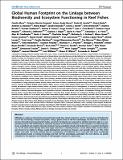Por favor, use este identificador para citar o enlazar a este item:
http://hdl.handle.net/10261/55207COMPARTIR / EXPORTAR:
 SHARE SHARE
 CORE
BASE CORE
BASE
|
|
| Visualizar otros formatos: MARC | Dublin Core | RDF | ORE | MODS | METS | DIDL | DATACITE | |

| Título: | Global human footprint on the linkage between biodiversity and ecosystem functioning in reef fishes. |
Autor: | Mora, Camilo; Aburto-Oropeza, Octavio; Ayala Bocos, Arturo; Ayotte, Paula M.; Banks, Stuart; Bauman, Andrew G.; Beger, Maria; Bessudo, Sandra; Booth, David J.; Brokovitch, Eran; Brooks, Andrew; Chabanet, Pascale; Cinner, Joshua E.; Cortés, Jorge; Cruz-Motta, Juan J.; Cupul Magaña, Amilcar; DeMartini, Edward E.; Edgar, Graham J.; Feary, David A.; Ferse, Sebastian C. A.; Friedlander, Alan M.; Gaston, Kevin J.; Gough, Charlotte; Sala, Enric CSIC | Fecha de publicación: | 2011 | Editor: | Public Library of Science | Citación: | PLoS Biology 9 (4) , art. no. e1000606 (2011) | Resumen: | Difficulties in scaling up theoretical and experimental results have raised controversy over the consequences of biodiversity loss for the functioning of natural ecosystems. Using a global survey of reef fish assemblages, we show that in contrast to previous theoretical and experimental studies, ecosystem functioning (as measured by standing biomass) scales in a non-saturating manner with biodiversity (as measured by species and functional richness) in this ecosystem. Our field study also shows a significant and negative interaction between human population density and biodiversity on ecosystem functioning (i.e., for the same human density there were larger reductions in standing biomass at more diverse reefs). Human effects were found to be related to fishing, coastal development, and land use stressors, and currently affect over 75% of the world's coral reefs. Our results indicate that the consequences of biodiversity loss in coral reefs have been considerably underestimated based on existing knowledge and that reef fish assemblages, particularly the most diverse, are greatly vulnerable to the expansion and intensity of anthropogenic stressors in coastal areas. | Descripción: | 9 páginas,4 figuras. | Versión del editor: | http://dx.doi.org/10.1371/journal.pbio.1000606 | URI: | http://hdl.handle.net/10261/55207 | DOI: | 10.1371/journal.pbio.1000606 | ISSN: | 1544-9173 | E-ISSN: | 1545-7885 |
| Aparece en las colecciones: | (CEAB) Artículos |
Ficheros en este ítem:
| Fichero | Descripción | Tamaño | Formato | |
|---|---|---|---|---|
| journal.pbio.1000606 (1).pdf | 507,11 kB | Adobe PDF |  Visualizar/Abrir |
CORE Recommender
PubMed Central
Citations
58
checked on 12-abr-2024
SCOPUSTM
Citations
233
checked on 19-abr-2024
WEB OF SCIENCETM
Citations
1.043
checked on 27-feb-2024
Page view(s)
419
checked on 24-abr-2024
Download(s)
236
checked on 24-abr-2024
Google ScholarTM
Check
Altmetric
Altmetric
Artículos relacionados:
NOTA: Los ítems de Digital.CSIC están protegidos por copyright, con todos los derechos reservados, a menos que se indique lo contrario.
